Rock Reinforcement by Stepwise Injection of Two-Component Silicate Resin
Abstract
1. Introduction
2. Materials and Methods
2.1. Materials
2.1.1. Sand
2.1.2. Two-Component Silicate Resin
2.2. Methods
- An installation of the replaceable cylindrical shell with a sand rock sample in the test chamber.
- A preparation of the required volume of component A of the resin solution and its injection into the rock sample. The component A is pumped in two ways. The first one is the sequentially pumping of small portions of the component A. To increase the impregnation of the sand rock the system is kept under pressure after each injection stage (Figure 4a). The second pumping approach is the injection of the full volume of the component A into the rock (Figure 4b).
- A pumping of the compressed nitrogen through the rock sample to extrude the injected component A deep into the rock (Figure 4a,b).
- A preparation and an injection of the component B into the rock sample. The component B is also pumped in the same two ways as the component A (see p.2). The injection schemes are shown in Figure 4a,b.
- A pumping of the compressed nitrogen through the rock sample to extrude the injected component B deep into the rock (Figure 4a,b).
- A time delay, which is required for the complete polymerization and achieving of sufficient strength properties of the cured resin.
- An installation of the replaceable cylindrical shell with a rock sample in the test chamber.
- Mixing the equal volumes of the two-component silicate resin components A and B. The injection of the prepared resin solution into the rock sample with a time delay at the maximum value of the injection pressure (Figure 5).
- A time delay, which is required for the complete polymerization and achieving sufficient strength properties of the cured resin.
3. Results and Discussion
4. Conclusions
- The reduction of polymer consumption per unit volume of the reinforced rock in comparison with the conventional method of prepared resin solution injection is observed. The increase of impregnation depth and the triple increase of the reinforced rock volume are observed.
- As seen in Figure 6, the cured polymer resin partially fills the sand pore space, binds the grains, and affects the reinforcing frame. As the result, large voids, located in the rock inter-granular space, are formed. Their size is on average 8 times larger than the small pores, which are located in the structure of the cured silicate resin;
- The higher strength properties at lower specific resin consumption per unit volume of the rock are observed. As seen in Figure 8 and Figure 9, the uniaxial compressive strength is on average more than 2 times higher than that obtained with the conventional injection method. The highest reinforcement efficiency is achieved with the sequential stepwise injection of the resin by separate small portions of each component. This can be explained by the higher fracture toughness of the reinforced rock with a flexible hardened network of the cured polymer resin compared to a more homogeneous structure, which is observed for the prepared resin solution injection. The cured polymer resin network probably prevents a formation of macro-cracks. The reinforced rock exhibits properties inherent in elastomers, but to a lesser extent than the cured polymer resin. These effects should be considered in further research.
Author Contributions
Funding
Institutional Review Board Statement
Data Availability Statement
Conflicts of Interest
References
- Sabri, M.M.S.; Vatin, N.I.; Alsaffar, K.A.M. Soil injection technology using an expandable polyurethane resin: A review. Polymers 2021, 13, 3666. [Google Scholar] [CrossRef]
- Liu, J.; Qi, X.; Zhang, D.; Feng, Q.; Wang, Y.; Kanungo, D.P. Study on the permeability characteristics of polyurethane soil stabilizer reinforced sand. Adv. Mater. Sci. Eng. 2017, 2017, 5240186. [Google Scholar] [CrossRef]
- Sabri, M.M.; Shashkin, K.G. The mechanical properties of the expandable polyurethane resin based on its volumetric expansion nature. Mag. Civ. Eng. 2020, 6, 9811. [Google Scholar] [CrossRef]
- Liang, Y.; Sui, W.; Qi, J. Experimental investigation on chemical grouting of inclined fracture to control sand and water flow. Tunn. Undergr. Space Technol. 2019, 83, 82–90. [Google Scholar] [CrossRef]
- Trifunović, P.; Tokalić, R.; Ganić, A. Application of polymer composites for stabilization of degraded rock mass in mining. Podzemn. Rad. 2013, 22, 23–31. [Google Scholar]
- Sabri, M.M.; Shashkin, K.G.; Zakharin, E.; Ulybin, A.V. Soil stabilization and foundation restoration using an expandable polyurethane resin. Mag. Civ. Eng. 2018, 82, 68–80. [Google Scholar] [CrossRef]
- Buzzi, O.; Fityus, S.; Sloan, S.W. Use of expanding polyurethane resin to remediate expansive soil foundations. Can. Geotech. J. 2010, 47, 623–634. [Google Scholar] [CrossRef]
- Anagnostopoulos, C.A. Strength properties of an epoxy resin and cement-stabilized silty clay soil. Appl. Clay Sci. 2015, 114, 517–529. [Google Scholar] [CrossRef]
- Liang, J.; Du, X.; Fang, H.; Du, M.; Shi, M.; Gao, X.; Han, Y. Numerical and experimental study of diffusion law of foamed polymer grout in fracture considering viscosity variation of slurry. Tunn. Undergr. Space Technol. 2022, 128, 104674. [Google Scholar] [CrossRef]
- Zhang, Q.S.; Zhang, L.Z.; Liu, R.T.; Li, S.C.; Zhang, Q.Q. Grouting mechanism of quick setting slurry in rock fissure with consideration of viscosity variation with space. Tunn. Undergr. Space Technol. 2017, 70, 262–273. [Google Scholar] [CrossRef]
- Gustafson, A.; Schunnesson, H.; Timusk, M.; Hauta, R. Productivity of rock reinforcement: Methodology development. J. South. Afr. Inst. Min. Metall. 2016, 116, 1127–1134. [Google Scholar] [CrossRef][Green Version]
- Saleh, S.; Yunus, N.Z.M.; Ahmad, K.; Ali, N. Improving the strength of weak soil using polyurethane grouts: A review. Constr. Build. Mater. 2019, 202, 738–752. [Google Scholar] [CrossRef]
- Song, Z.; Liu, J.; Bai, Y.; Shi, X.; Kanungo, D.P.; Qi, C.; Bu, F. Investigation of Temperature Effect on Strength Properties of Polyurethane-Treated Sand. J. Mater. Civ. Eng. 2021, 33, 04020482. [Google Scholar] [CrossRef]
- Lan, X.; Zhang, X.; Li, X.; Zhang, J.; Zhou, Z. Experimental study on grouting reinforcement mechanism of heterogeneous fractured rock and soil mass. Geotech. Geol. Eng. 2020, 38, 4949–4967. [Google Scholar] [CrossRef]
- Chen, Z.; Zhu, S.S. In-situ polymerization of dicyclopentadiene for rock reinforcement. J. Pet. Sci. Eng. 2019, 173, 912–921. [Google Scholar] [CrossRef]
- Lavín, J.R.S.; Sánchez, F.E.; de la Serna, A.M. Chemical injections realized with null pressure for underpinning the foundation of an 18th Century Building located in the historical city of Cuenca (Spain). Appl. Sci. 2018, 8, 1117. [Google Scholar] [CrossRef]
- Granata, R.; Vanni, D.; Mauro, M. New experiences in ground treatment by permeation grouting. In Proceedings of the Grouting and Deep Mixing 2012, New Orleans, LA, USA, 15–18 February 2012; pp. 2013–2023. [Google Scholar] [CrossRef]
- Soucek, K.; Scucka, L.S.J.; Martinec, P. Chemical Grouting–Laboratory Study of Chemical Grouts and Geocomposites Properties. In Proceedings of the International Conference IACMAG/12 Bombay: Indian Institute of Technology, Bombay, India, 1–6 October 2008; pp. 3567–3574. [Google Scholar]
- Nowamooz, H. Resin injection in clays with high plasticity. C. R. Mécanique 2016, 344, 797–806. [Google Scholar] [CrossRef]
- Liu, J.; Bu, F.; Bai, Y.; Chen, Z.; Kanungo, D.P.; Song, Z.; Chen, J. Study on engineering properties of sand strengthened by mixed fibers and polyurethane organic polymer. Bull. Eng. Geol. Environ. 2020, 79, 3049–3062. [Google Scholar] [CrossRef]
- Chen, Q.; Yu, R.; Li, Y.; Tao, G.; Nimbalkar, S. Cyclic stress-strain characteristics of calcareous sand improved by polyurethane foam adhesive. Transp. Geotech. 2021, 31, 100640. [Google Scholar] [CrossRef]
- Anagnostopoulos, C.; Hadjispyrou, S. Laboratory study of an epoxy resin grouted sand. Proc. Inst. Civ. Eng. Ground Improv. 2004, 8, 39–45. [Google Scholar] [CrossRef]
- Anagnostopoulos, C.A. Laboratory study of an injected granular soil with polymer grouts. Tunn. Undergr. Space Technol. 2005, 20, 525–533. [Google Scholar] [CrossRef]
- Mollamahmutoglu, M.; Littlejohn, S. Varying temperature and creep of silicate grouted sand. Ground Improv. 1997, 1, 59–64. [Google Scholar] [CrossRef]
- Delavar, I.N.; Noorzad, R. Drained shear strength parameters of silty sand grouted by colloidal silica. Int. J. Geotech. Eng. 2017, 14, 1–8. [Google Scholar] [CrossRef]
- Butrón, C.; Axelsson, M.; Gustafson, G. Silica sol for rock grouting: Laboratory testing of strength, fracture behaviour and hydraulic conductivity. Tunn. Undergr. Space Technol. 2009, 24, 603–607. [Google Scholar] [CrossRef]
- Pedrotti, M.; Wong, C.; El Mountassir, G.; Renshaw, J.C.; Lunn, R.J. Desiccation behaviour of colloidal silica grouted sand: A new material for the creation of near surface hydraulic barriers. Eng. Geol. 2020, 270, 105579. [Google Scholar] [CrossRef]
- Todaro, C. Grouting of cohesionless soils by means of colloidal nanosilica. Case Stud. Constr. Mater. 2021, 15, e00577. [Google Scholar] [CrossRef]
- Sakhno, I.; Korzeniowski, W.; Sheptak, K.; Sakhno, S. Influence of adhesion on stress-strain condition alongside of a full column resin cartridge rock bolt. Min. Sci. 2021, 28, 233–245. [Google Scholar] [CrossRef]
- Šňupárek, R.; Souček, K. Laboratory testing of chemical grouts. Tunn. Undergr. Space Technol. 2000, 15, 175–185. [Google Scholar] [CrossRef]
- Ortiz, R.C. Mechanical behavior of grouted sands. Master’s Thesis, College of Engineering at the University of Kentucky, Lexington, KY, USA, 2015. [Google Scholar]
- Wang, Y.; Han, M.; Li, B.; Wan, Y. Stability evaluation of earth-rock dam reinforcement with new permeable polymer based on reliability method. Constr. Build. Mater. 2022, 320, 126294. [Google Scholar] [CrossRef]
- GOST Standard 12536-2014; Soils. Methods of laboratory granulometric (grain-size) and microaggregate distribution. Standards Publishing House: Moscow, Russia, 2014. (In Russian)
- GOST Standard 5180-2015; Soils. Laboratory methods for determination of physical characteristics. Standards Publishing House: Moscow, Russia, 2015. (In Russian)
- Cornely, W. Elastified silicate resins and polyurethane foam resins for the stabilization of strata-a comparison. In Proceedings of the 6th International Seminary Reinforcement and Sealing of Rock and Construction at the Beginning of 21st Century, Ostrava, Czech Republic, February 2001. Available online: http://fast10.vsb.cz/science/konf-02-2001/pics/02.pdf (accessed on 6 November 2022).
- GOST R Standard 58144-2018; Distilled Water. Specifications. Standards Publishing House: Moscow, Russia, 2018. (In Russian)
- Askadskiy, A. Deformation of Polymers; Chemistry: Moscow, Russia, 1973; p. 448. (In Russian) [Google Scholar]
- Liu, H.; Wang, F.; Shi, M.; Tian, W. Mechanical behavior of polyurethane polymer materials under triaxial cyclic loading: A particle flow code approach. J. Wuhan Univ. Technol. Mater. Sci. Ed. 2018, 33, 980–986. [Google Scholar] [CrossRef]
- Shilova, T.V.; Rybalkin, L.A. Study of polymer compositions for formation of impermeable inclusions in rock mass. In IOP Conference Series: Earth and Environmental Science; IOP Publishing: Bristol, UK, 2022; Volume 991, p. 012008. [Google Scholar] [CrossRef]
- Wang, J.; Li, X.; Wang, C.; Zhang, C.; Fang, H.; Deng, Y. Quantitative analysis of the representative volume element of polymer grouting materials based on geometric homogenization. Constr. Build. Mater. 2021, 300, 124223. [Google Scholar] [CrossRef]
- Milliken, K.L.; Curtis, M.E. Imaging pores in sedimentary rocks: Foundation of porosity prediction. Mar. Pet. Geol. 2016, 73, 590–608. [Google Scholar] [CrossRef]
- GOST Standard 21153.2-84; Rocks. Methods for Determination of Uniaxial Compressive Strength. Standards Publishing House: Moscow, Russia, 2001. (In Russian)
- ASTM Standard D2166-06; Standard Test Method for Unconfined Compressive Strength of Cohesive Soil. Annual Book of ASTM Standards. ASTM International: West Conshohocken, PA, USA, 2006.
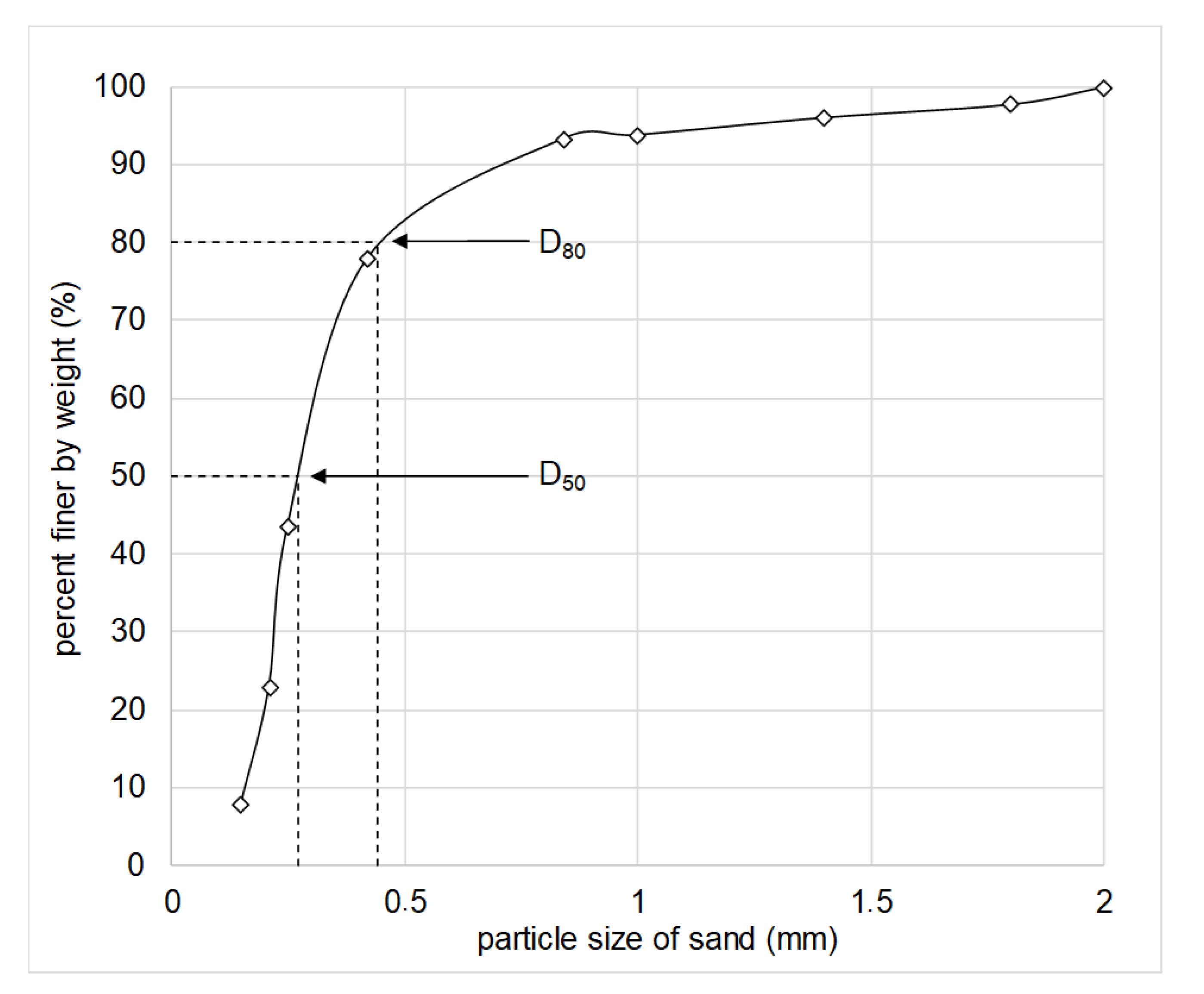

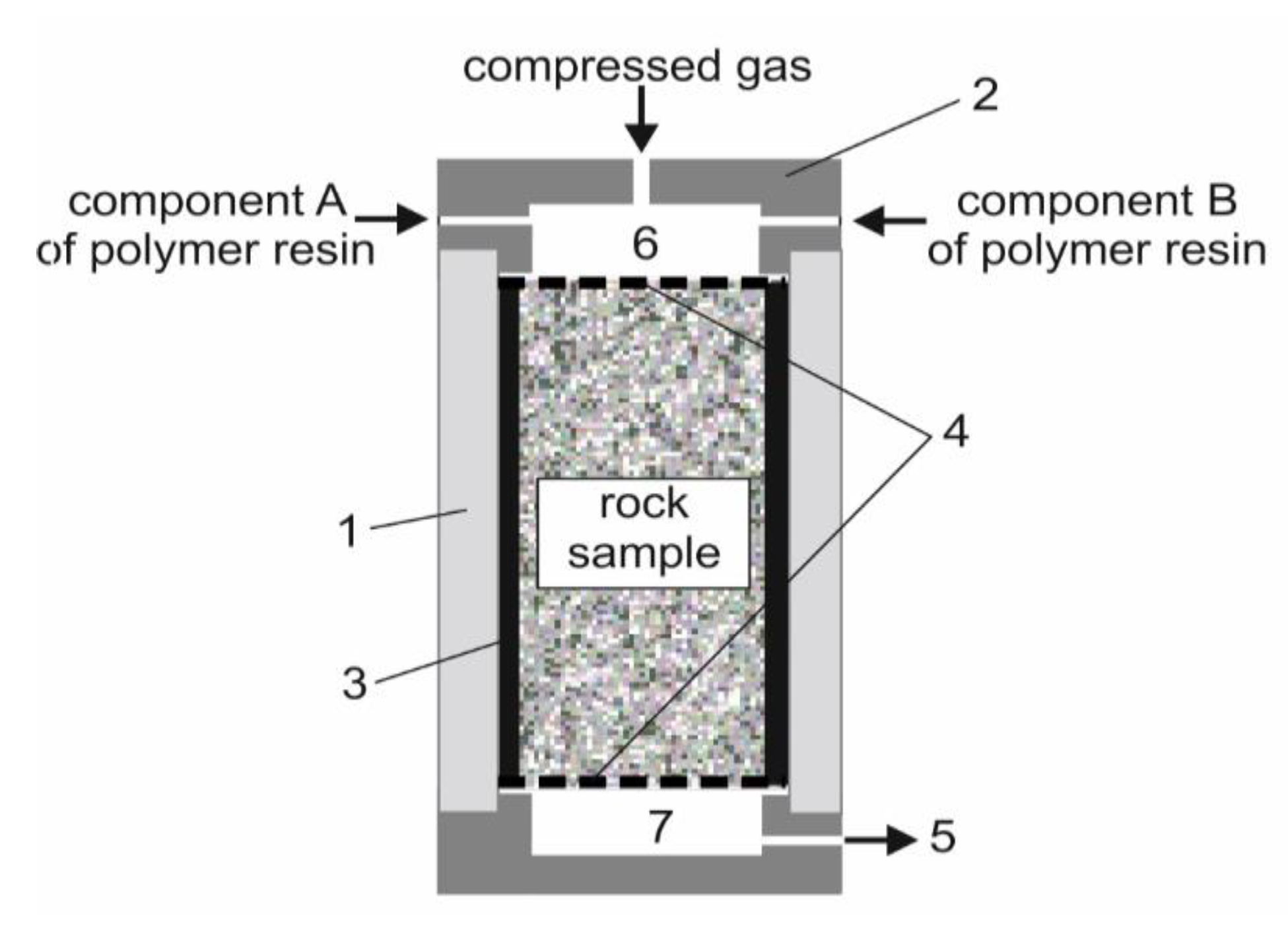

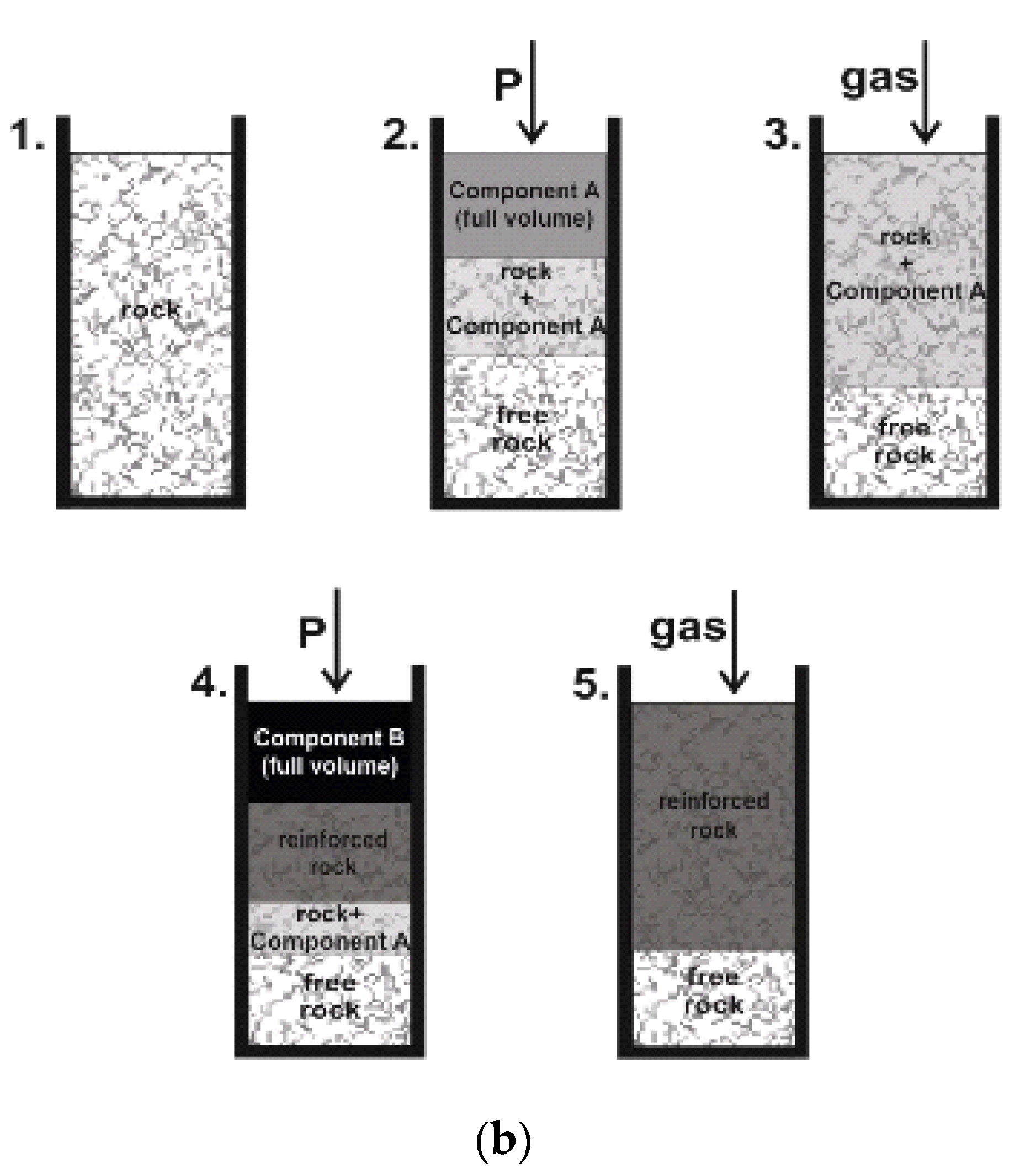
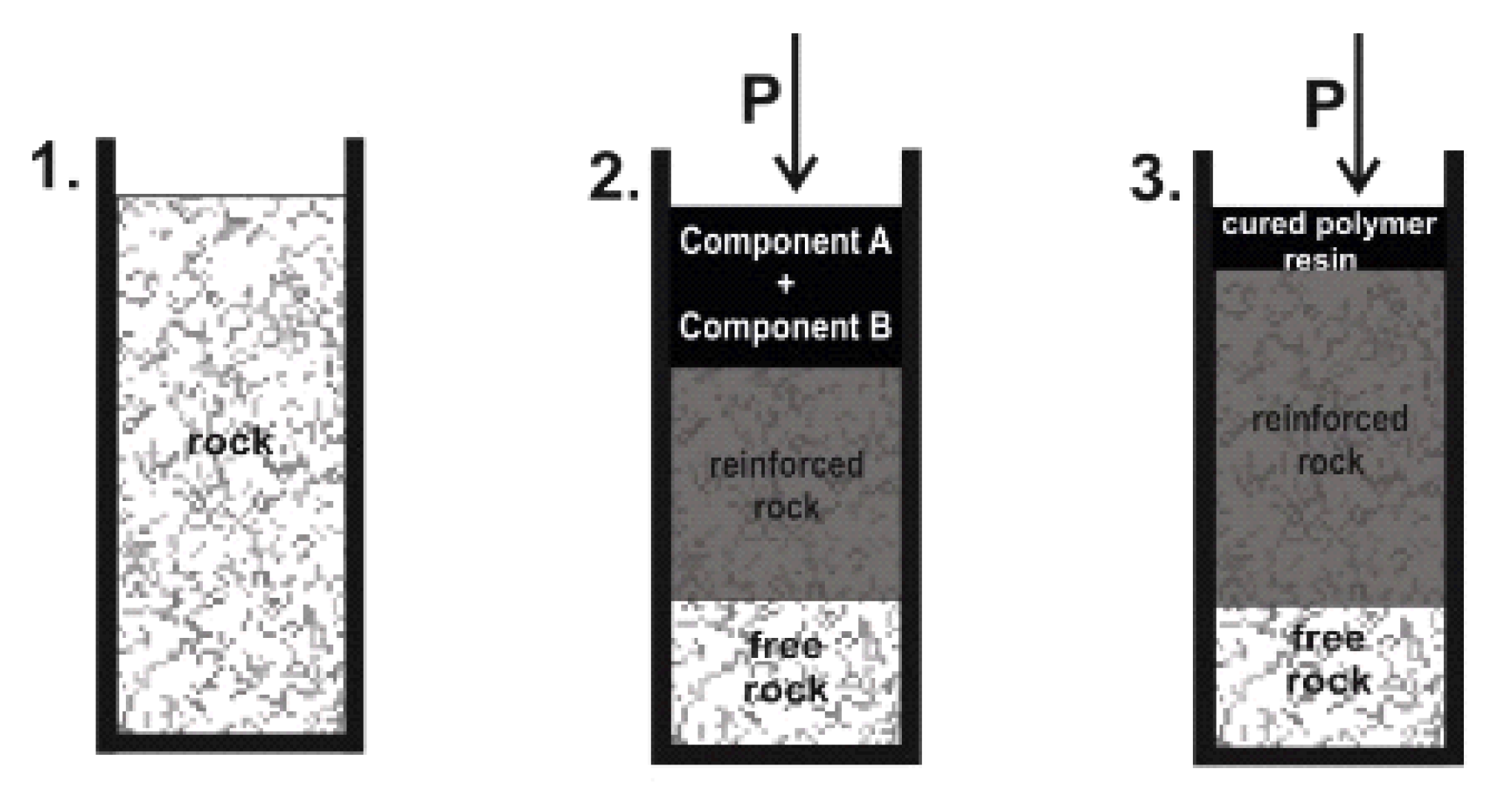

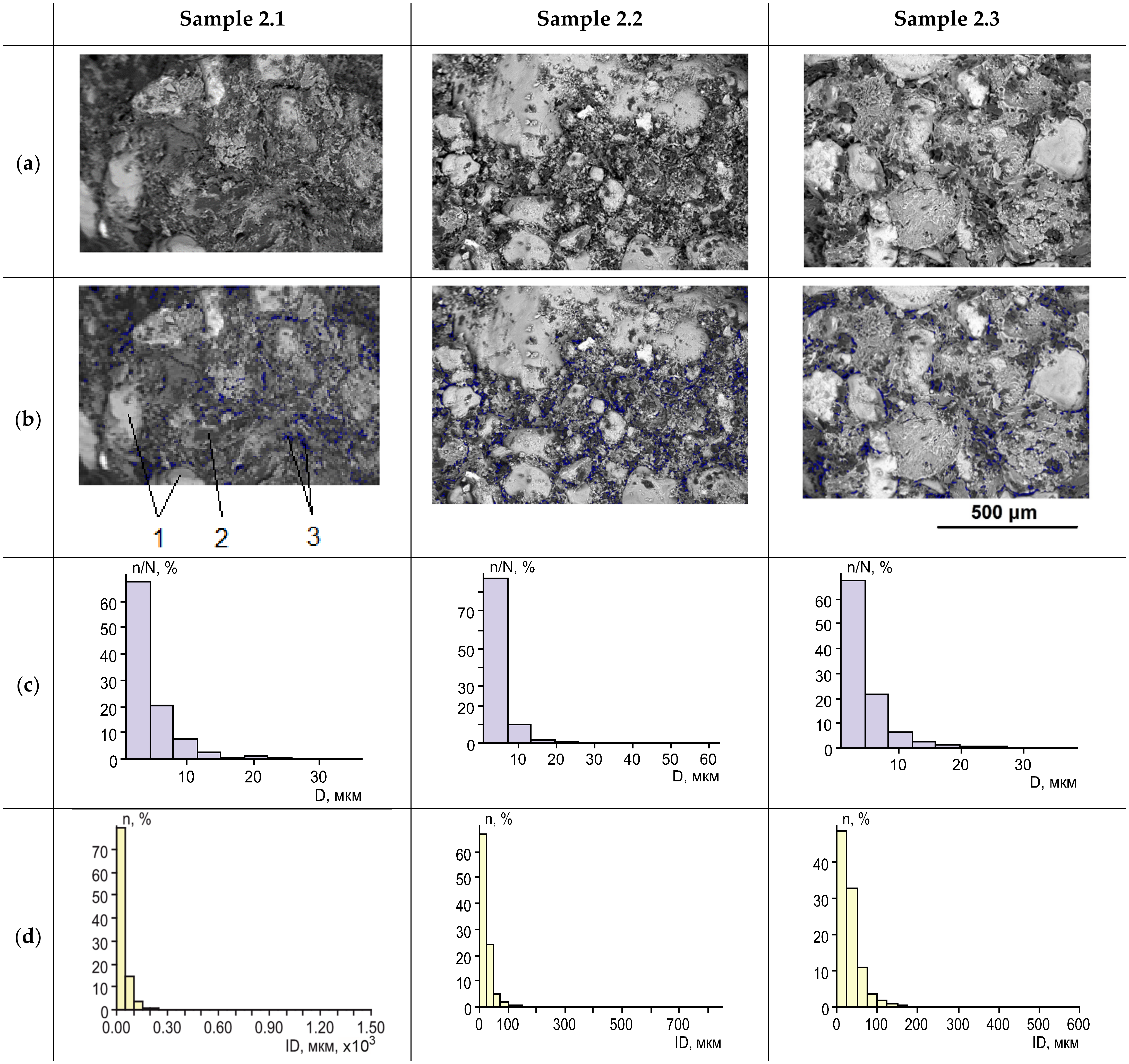
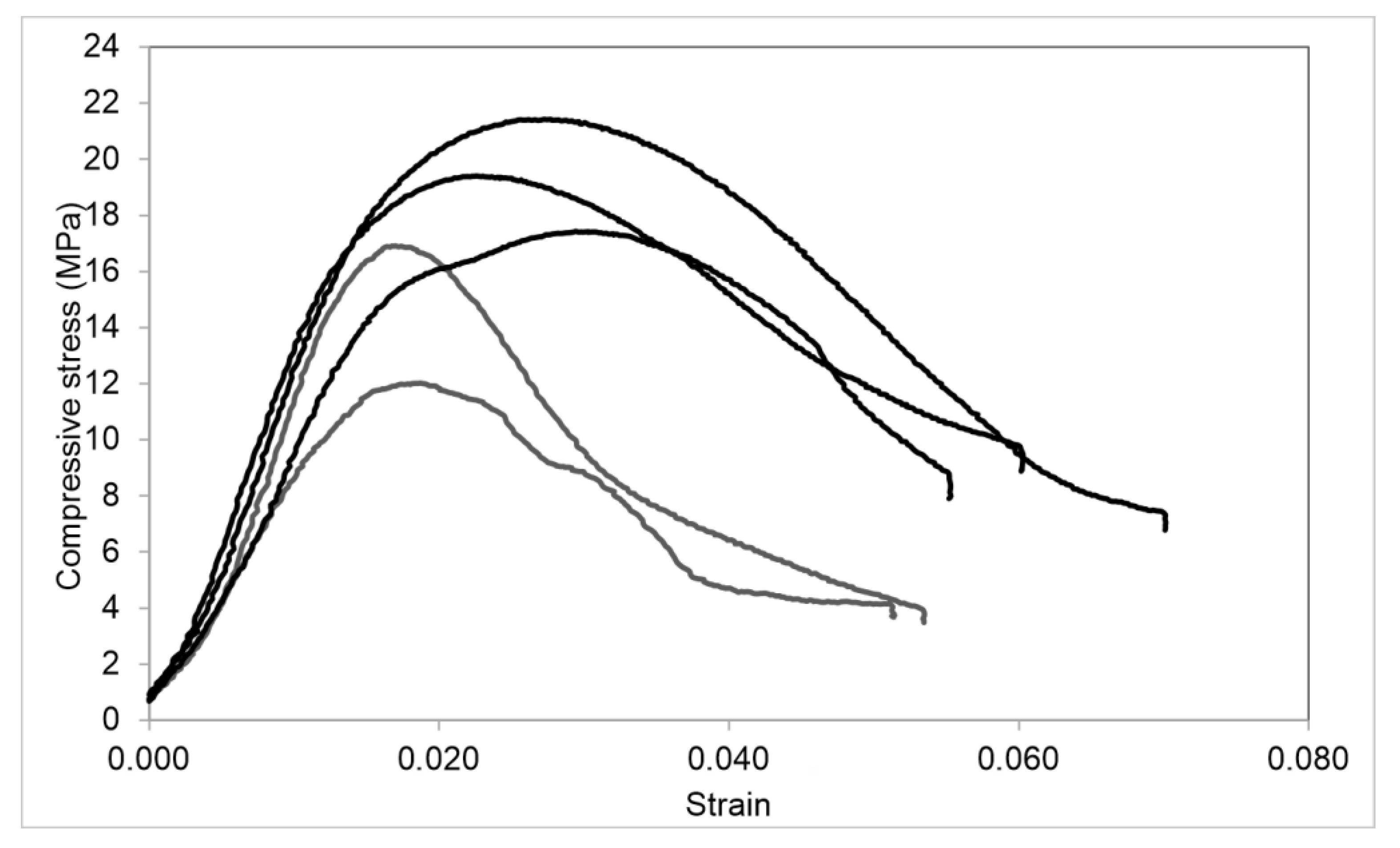
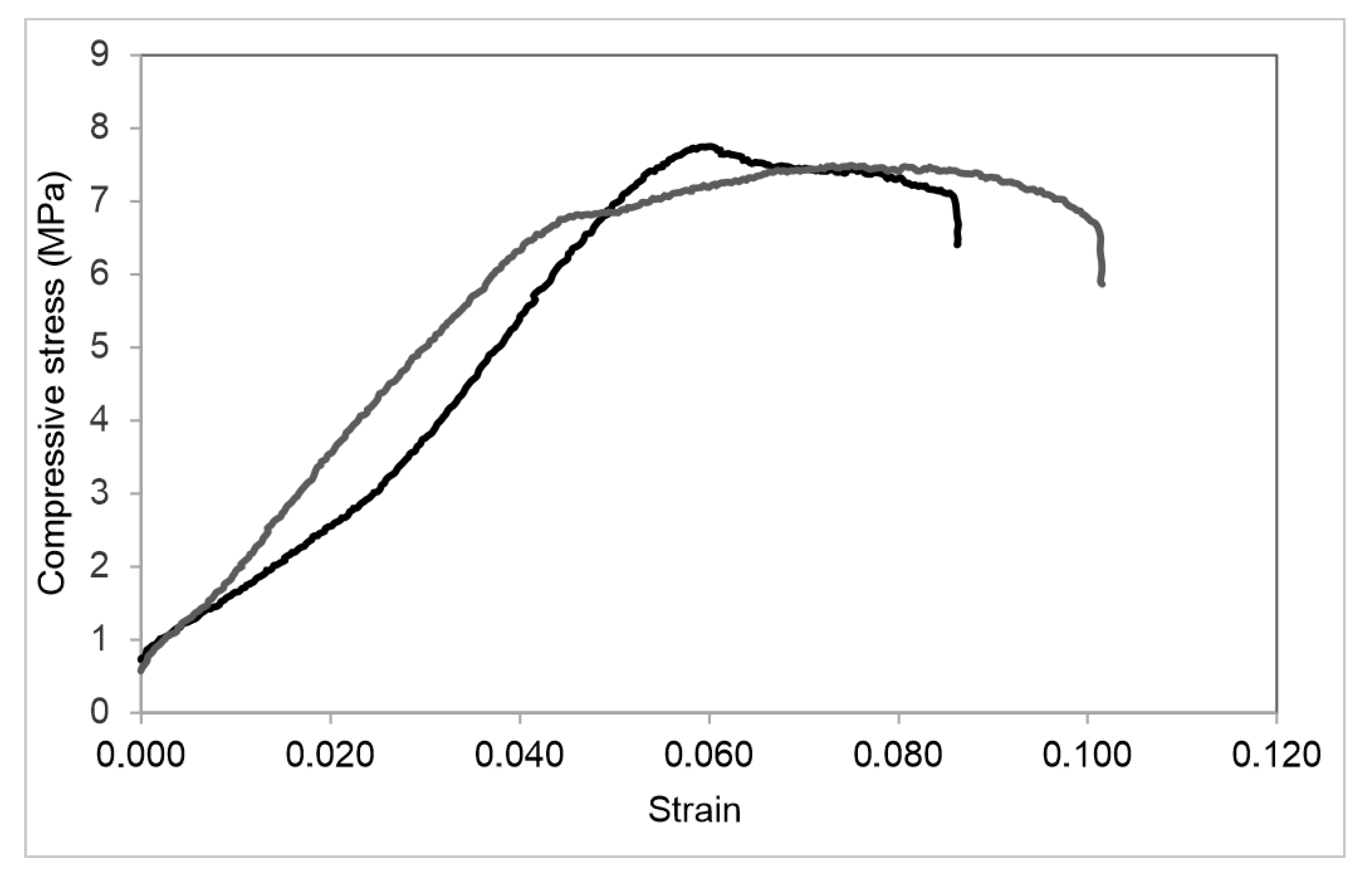
| Composition | Technical Document | Appearance | Properties |
|---|---|---|---|
| Sodium silicate solution | CAS 1344-09-8 | Thick clear yellow or gray liquid | Silicate module 2.3–2.8; density at 20 °C 1.45–1.50 g/cm3 |
| Glycerol | CAS 56-81-5 | Odorless, viscous, clear, hygroscopic liquid | Glycerine content ≥ 99.5 wt. %; density at 20 °C ≥ 1.255 g/cm3; boiling temperature 290 °C |
| Distilled water | GOST R 58144-2018 [36] | Colorless liquid | - |
| DMDEE (2,2-Dimorpholinodiethylether) | CAS 6425-39-4 | Yellowish liquid with an amine odor | Density at 25 °C 1.06 g/cm3; viscosity at 20 °C 29 mPas; boiling temperature 309 °C; ignition temperature 146 °C |
| Polymethylene polyphenyl isocyanate (Wannate PM-200) | CAS 9016-87-9 | Dark brown thick liquid | NCO content: 30.0–30.2 %; viscosity at 25 °C 200–250 mPas; density at 25 °C 1.22–1.25 g/cm3 |
| Dibutyl phthalate | CAS 84-74-2 | Clear liquid without mechanical impurities | Density at 20 °C 1.045–1.049 g/cm3; flash point 168 °C |
| Parameter | Value |
|---|---|
| The volume ratio of components A and B for mixing | 1:1 |
| Time of the start of the polymerization reaction, s | 135–150 |
| Time of the complete curing, s | 210–240 |
| Foam factor | 1 |
| Temperature (max) of reaction, °C | ≤75 |
| Density at 25C (Component A/Component B), g/cm3 | 1.38/1.16 |
| Viscosity at 25C (Component A/Component B), mPa·s | 137 ± 2/131 ± 5 |
| Uniaxial compressive strength, MPa | 20–23 |
Publisher’s Note: MDPI stays neutral with regard to jurisdictional claims in published maps and institutional affiliations. |
© 2022 by the authors. Licensee MDPI, Basel, Switzerland. This article is an open access article distributed under the terms and conditions of the Creative Commons Attribution (CC BY) license (https://creativecommons.org/licenses/by/4.0/).
Share and Cite
Shilova, T.; Serdyukov, A.; Serdyukov, S.; Ivanova, O. Rock Reinforcement by Stepwise Injection of Two-Component Silicate Resin. Polymers 2022, 14, 5251. https://doi.org/10.3390/polym14235251
Shilova T, Serdyukov A, Serdyukov S, Ivanova O. Rock Reinforcement by Stepwise Injection of Two-Component Silicate Resin. Polymers. 2022; 14(23):5251. https://doi.org/10.3390/polym14235251
Chicago/Turabian StyleShilova, Tatiana, Aleksander Serdyukov, Sergey Serdyukov, and Oksana Ivanova. 2022. "Rock Reinforcement by Stepwise Injection of Two-Component Silicate Resin" Polymers 14, no. 23: 5251. https://doi.org/10.3390/polym14235251
APA StyleShilova, T., Serdyukov, A., Serdyukov, S., & Ivanova, O. (2022). Rock Reinforcement by Stepwise Injection of Two-Component Silicate Resin. Polymers, 14(23), 5251. https://doi.org/10.3390/polym14235251





